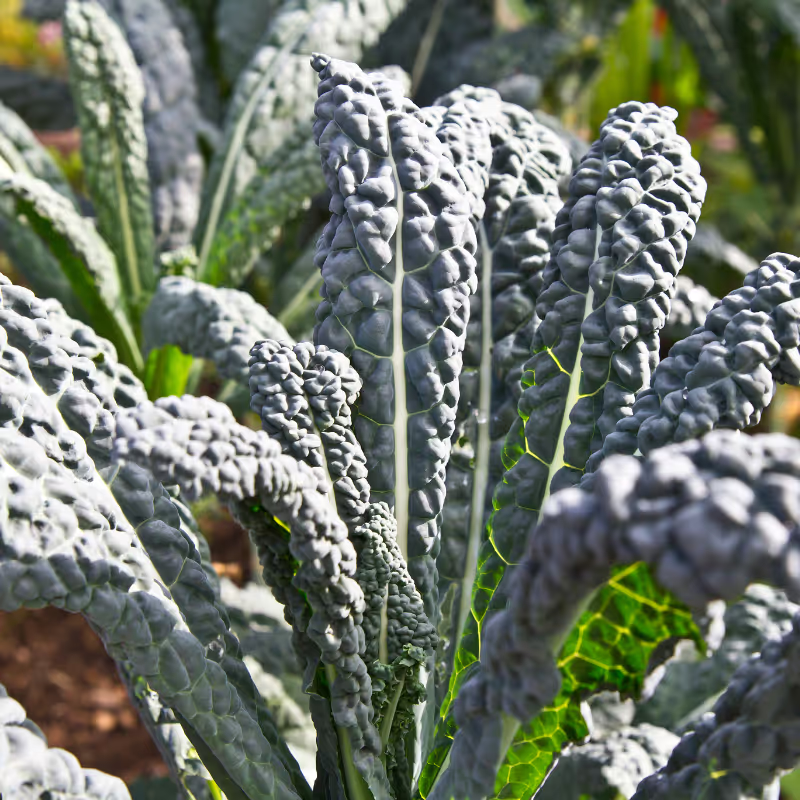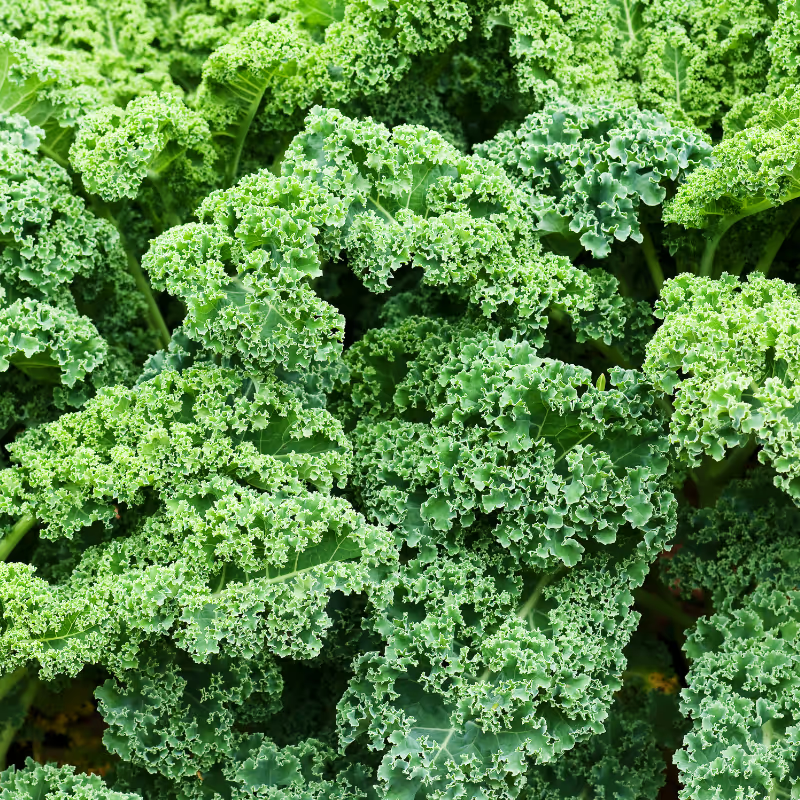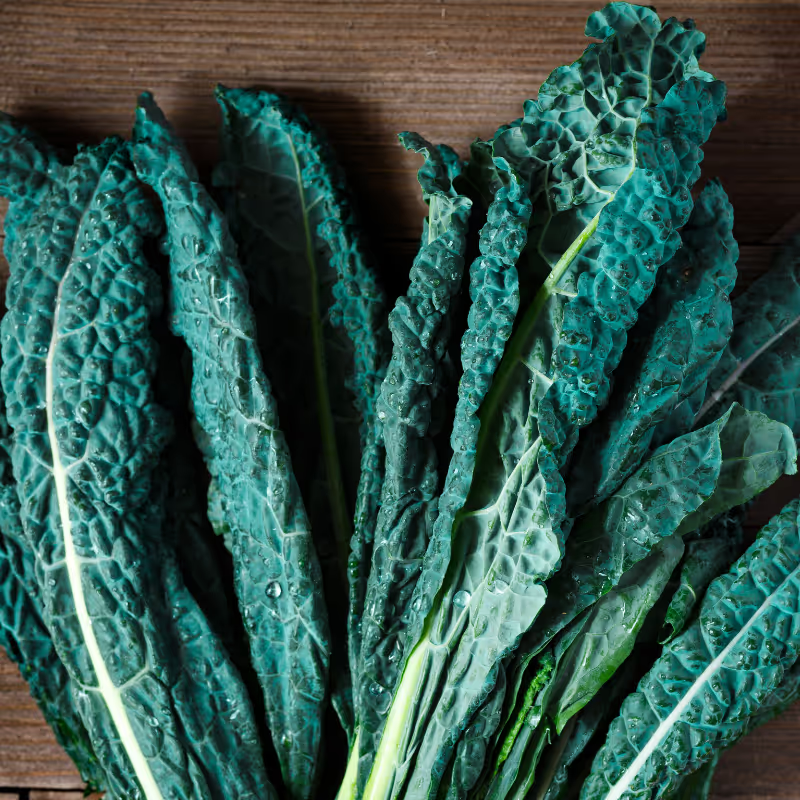What Does it Taste Like?
Kale has a slightly bitter and earthy flavor that can vary depending on the variety and freshness. Some types of kale, such as curly kale, have more pungent and peppery notes, while others, such as dinosaur kale, have a sweeter and nuttier taste. The texture of kale is also different depending on how you prepare it. Raw kale can be tough and chewy, but it becomes softer and more tender when cooked. Kale can also be crispy and crunchy when roasted or baked.
Varieties we grow

Black Magic
This dark, crinkled-leaf kale has a tender yet sturdy texture with a rich, earthy flavor. Perfect for massaging into salads, blending into smoothies, or sauteing with garlic and olive oil, it also crisps up beautifully into kale chips.

Winterbor
This is a type of curly kale that is popular and hardy. It has dark green, deeply curled, and textured leaves that add volume and crunch to any dish. It has a rich, earthy, and slightly bitter flavor that is great for baking, pickling, or soups.

Dazzling Blue
This is a type of Lacinato kale that has a stunning appearance and flavor. It has blue-green, strap-like leaves that are puckered and have bright pink midribs. It has a sweet, complex, and slightly peppery flavor that is ideal for salads, soups, and stir-fries.
Why Should I Eat It?
The term super food gets tossed around a lot, but kale is one food that has definitely earned this title. Its one of the most nutrient-dense foods you can eat.
- One cup of raw kale (21 grams) provides only 7 calories but is an excellent source of vitamins A, K, and C, as well as a good source of manganese, calcium, copper, potassium, magnesium, and several B vitamins.
- Kale also contains phytochemicals, such as chlorophyll, that can help prevent the body from absorbing harmful substances.
- Kale has anti-inflammatory and anti-cancer properties, thanks to its high content of antioxidants, such as beta-carotene, lutein, and quercetin.
- Kale can also help lower cholesterol, blood pressure, and blood sugar levels, as well as support digestion and immunity.
Kale

May - February
If you’re looking for a way to add more highly nutritious greens to your diet, look no further than kale. Kale is a leafy vegetable that belongs to the same family as cabbage, broccoli, and Brussels sprouts. It has been cultivated for centuries and is widely used in many cuisines around the world. Kale is not only delicious, but also nutritious. It is rich in vitamins, minerals, antioxidants, and fiber that can benefit your health in many ways.
Recommended Storage
How Do I Store It?
Short Term
The best way to store kale depends on how you plan to use it and how long you want to keep it. Here are some general tips for storing kale:
- If you want to store a whole bunch of kale, do not wash it until you are ready to use it. Excess moisture can cause the kale to spoil faster. Wrap the kale in a layer of paper towels and place it in a zip-top plastic bag or a hard-sided storage container. Store it in the crisper drawer of your refrigerator for up to a week. The stems should face the back of the fridge, where the air is colder.
- If you want to store washed and prepped kale, make sure to dry it well with a salad spinner or paper towels. You can stem, slice, or tear the kale leaves as you prefer. Wrap the kale in a paper towel and place it in a zip-top plastic bag or a hard-sided storage container. Store it in the refrigerator for up to three days.
Long Term
- Freezing: If you want to freeze kale for smoothies, soups, stews, or other dishes, you need to blanch it first. Dry the blanched kale thoroughly and freeze it flat on a baking sheet. Once frozen, transfer the kale to a freezer bag and store it in the freezer for up to six months.
- Pickling: Pickled kale is a zesty addition to salads and sandwiches. Leaves can be pickled whole, or just the thick stems. You can also use kale in place of cabbage when making fermented foods like kimchi.
- Canning: The thick, sturdy leaves of kale holds up well to the high heat of canning. You'll want to use a pressure canner for this, since it's a low acid food.
- Dehydrating: Did someone say kale chips? You can make them in either a dehydrator or the oven. To make kale chips, wash and destem the leaves and tear into large chunks. Drizzle with a little olive oil and whatever seasoning you want. Dry them in a food dehydrator at 125°F for about 2 hours, or in the oven at 225°F for about 30 minutes.
How Do I Cook It?
- Steaming: This the simplest and quickest ways to cook kale. Just bring a pot of water to a boil, place the kale in a steamer basket over the water, and cook the kale for a few minutes until tender. Steaming kale can help retain its nutrients and color, but it can also dilute its flavor. To enhance the taste, you can add some lemon juice, vinegar, or herbs or drizzle some olive oil or butter over the cooked kale.
- Sautéing and stir-frying: These are the best ways to cook kale if you want to add some flavor and texture. Heat some oil or butter in a large skillet over medium-high heat, add some garlic, onion, or other aromatics, and cook for a few minutes until fragrant. Then, add the kale and some salt, pepper, and other seasonings, and cook, stirring occasionally, for about 10 to 15 minutes, or until the kale is wilted and crisp. You can also add some water, broth, wine, or soy sauce to the skillet to create some sauce and prevent the kale from burning. Sautéing and stir-frying kale can bring out its natural sweetness and crispiness, as well as infuse it with other flavors.
- Roasting and baking: These are the best ways to cook kale if you want to make it crispy and crunchy. Preheat the oven to 375°F (190°C) and line a baking sheet with parchment paper. Remove the stems from the kale and tear the leaves into bite-sized pieces. Wash and dry the kale thoroughly, then toss it with some oil, salt, pepper, and other spices. Spread the kale in a single layer on the prepared baking sheet and bake for 15 to 20 minutes, or until the edges are browned and crisp. You can also sprinkle some cheese, nuts, or seeds over the kale before or after baking for extra flavor and crunch. Roasting and baking kale can make it taste like chips or crackers, which is great for snacking or topping salads and soups.
- Soups and Stews: Because kale is such a hardy green, it holds up well in soups and stews without losing its shape and texture. It can also help thicken the soup or stew, as it absorbs some of the moisture and creates a more hearty and satisfying dish. Kale can pair well with various ingredients, such as beans, potatoes, carrots, tomatoes, chicken, beef, or pork, depending on the type of soup or stew you want to make.
What Goes Well With It?
Kale has a strong and distinctive flavor that can pair well with many other ingredients. Here are some of the best flavor pairings for kale:
- Lemon: The acidity and freshness of lemon can balance the bitterness and earthiness of kale. You can squeeze some lemon juice over cooked or raw kale, or make a lemon dressing with lemon zest, lemon juice, olive oil, honey, salt, and pepper. Lemon also enhances the absorption of iron from kale, which is important for your blood and energy levels.
- Garlic: The pungency and aroma of garlic can complement the flavor and texture of kale. You can sauté some garlic with kale, or roast some garlic cloves and mash them with kale for a creamy and savory side dish. Garlic also has antibacterial and antiviral properties that can boost your immune system.
- Onion: The sweetness and crunch of onion can contrast the bitterness and chewiness of kale. You can chop some onion and add it to kale salads, soups, or stir-fries, or caramelize some onion slices and serve them with kale for a rich and sweet topping.
- Bacon: The smokiness and saltiness of bacon can cut through the bitterness and earthiness of kale. You can cook some bacon pieces and use the rendered fat to sauté the kale, or crumble some bacon bits and sprinkle them over the kale for a crunchy and savory topping. Bacon also adds some protein and fat to the kale, making it more filling and satisfying. Bacon and kale are a classic combination that can be found in many dishes, such as salads, soups, pastas, or casseroles.
- Dairy: The creaminess and richness of dairy can soften the texture and flavor of kale. You can add some cheese, cream, yogurt, or milk to the kale, or make a creamy sauce with butter, flour, and cheese. Dairy also adds some calcium and protein to the kale, which are important for your bones and muscles. Dairy and kale are a delicious pairing that can be enjoyed in many ways, such as dips, quiches, pies, or gratins.
